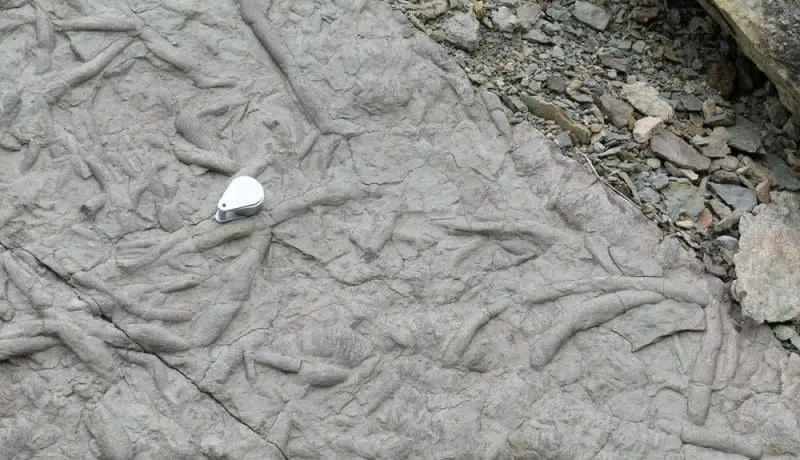[Originally published as Grand Canyon Fossil Discovery: A Snapshot of Life Before the Flood]
A recent article from Phys.org announced the discovery of exquisitely preserved Cambrian fossils in the Grand Canyon’s Bright Angel Formation. These fossils include soft-bodied creatures like worms, crustaceans, and mollusk-like animals, preserved with stunning detail. Secular scientists are interpreting this find as evidence of a thriving ecosystem that existed some 500 million years ago, providing a window into what they call the “Cambrian Explosion” — a period of rapid evolutionary diversification in the distant past.
As Christians who hold to the authority of Scripture and a young earth, global Flood model, how should we respond to such discoveries?
Do these fossils undermine the biblical account of a recent creation and Noah’s Flood—or do they, in fact, confirm it?
What Was Actually Found
Explore a captivating 3D geological diagram showcasing the Grand Canyons stratigraphy, with features like the Uinkaret Plateau basalts, deep basement rocks, and layers such as Kaibab and Coconino along paths like the iconic Bright Angel Corridor. Each layer reveals its own story. The fossils were discovered in the Bright Angel Formation, a rock layer that lies above the Tapeats Sandstone and below the Muav Limestone in the Grand Canyon. This group of rocks, called the Tonto Group, is well known for its marine fossils, such as trilobites and brachiopods.
Other fossil finds include:
- Soft-bodied organisms such as priapulid worms,
- Crustacean-like animals,
- Early mollusk-like creatures,
- And various burrow-making organisms.
Most of these creatures are understood to be seafloor dwellers, living on or just beneath the sediment surface in a marine environment. According to the secular narrative, these animals lived, died, and were slowly buried over millions of years as sediments accumulated on the continental shelf.
The Challenge of Soft-Bodied Fossils
Soft tissues are notoriously fragile. They decay rapidly, often within days or even hours after death. For them to be preserved in exquisite detail, they must be buried quickly and completely, sealed off from scavengers, oxygen, and bacterial decay.
This raises an important question:
If these fossils truly formed in calm, stable environments over millions of years, why didn’t the soft tissues decompose long before they were buried?
From a biblical Flood perspective, the answer is clear:
These creatures were buried suddenly by catastrophic sediment flows, exactly what we would expect at the onset of the global Flood described in Genesis 7:11, when “all the fountains of the great deep burst forth.”
Rather than pointing to slow, gradual processes, the very existence of these fossils is powerful evidence for rapid burial during a violent, world-changing event.
Early Flood Deposits

The sequence of layers in the Grand Canyon tells a story — not of evolution over millions of years, but of ecological zones being buried in succession during the Flood.
The Tonto Group represents some of the earliest deposits of the Flood:
- Tapeats Sandstone – Rapidly laid down as massive waves of water surged onto the continents, carrying sand and sediment.
- Bright Angel Shale – Finer sediments like silt and clay settled next, burying the marine creatures found in this new discovery.
- Muav Limestone – Representing continued deposition as the waters deepened.
These layers reflect the destruction of seafloor ecosystems at the very start of the Flood. As the catastrophe progressed, waves moved inland, eventually burying coastal life, land plants, and terrestrial animals, including dinosaurs and mammals, higher up in the geologic record.
This ecological zonation explains why marine fossils are consistently found at the bottom and land animals higher up—not because they evolved at different times, but because they lived in different environments and were overwhelmed in sequence.
A Thriving Pre-Flood World
The article emphasizes the complexity of this Cambrian ecosystem: predators, prey, burrowers, filter feeders — a fully functioning web of life.
From a biblical perspective, this is exactly what we would expect:
- God created all creatures fully formed and functional, with intricate ecological relationships, from the very beginning (Genesis 1).
- The diversity seen here reflects the richness of the pre-Flood world, not the result of millions of years of evolutionary trial and error.
- The discovery actually highlights God’s design, showing that even the earliest creatures were complex and well-adapted to their environment.
The Real Timeline: Not 500 Million Years
The secular dating of these fossils relies on assumptions built into radiometric dating methods and uniformitarian thinking — the belief that the processes we see today have always operated at the same slow pace in the past.
Biblical creationists understand that:
- The Flood was a unique, unrepeatable global catastrophe.
- Rates of sedimentation, erosion, and deposition during the Flood were orders of magnitude greater than anything we see today.
- When we start with the Bible’s timeline, these rock layers were laid down just thousands of years ago, not millions.
Thus, the “500 million years” assigned to these fossils is a misinterpretation of the evidence, not a neutral fact.
Reframing the Discovery
Instead of seeing this as a threat to the Bible, we can view this discovery as a snapshot of life suddenly destroyed in the early stages of God’s judgment on the earth.
- The incredible detail of the fossils points to rapid burial.
- The presence of complex ecosystems shows that life was diverse and fully formed from the start.
- The order of burial matches what we would expect from a global, catastrophic Flood rather than gradual processes.
Conclusion: Awe and Worship
When we look at the Grand Canyon and discoveries like this, we are reminded of two things:
- God’s power as Creator—He spoke complex ecosystems into existence, fully formed and functional.
- God’s holiness and justice—The Flood was a real, global event through which God judged a sinful world, while also preserving Noah and his family as an act of mercy.
As Psalm 104:24 declares:
O Lord, how manifold are Your works! In wisdom have You made them all; the earth is full of Your creatures.
Rather than shaking our faith, discoveries like this deepen our awe of the Creator and affirm the reliability of His Word. The rocks cry out — not of millions of years — but of the catastrophic judgment and redeeming grace described in the pages of Scripture.






